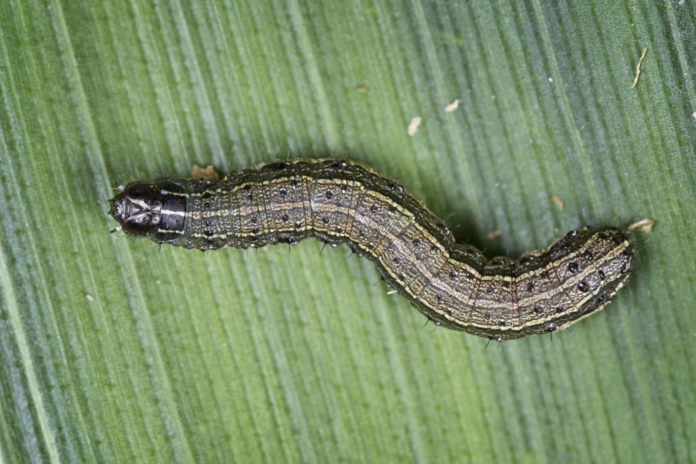CULLMAN, Ala. – Folks across Cullman County are seeing an increase in brown caterpillars that are helping themselves to lawns, gardens and crops. What are they, and what can be done to stop the damage?
The fall armyworm, called “army” because of its invasive tendencies, is considered a destructive species and, once you see the big caterpillars crawling across your patio or driveway, it may be too late to fight them.
According to Katelyn Kesheimer and Scott Graham, extension officials with Alabama A&M and Auburn University, “Alabama is experiencing a high number of migrating fall armyworm moths. Additionally, the state has experienced numerous rainfall events to put the yearly total above average. This frequency of rain creates a favorable environment for fall armyworm eggs and larvae to survive in large numbers. It also creates lush, green fields that attract armyworms. In some cases, producers are unable to access fields for control because of excess water.”
The officials released a briefing on Monday for extension agents across the state who are fielding higher than average numbers of calls about the pests.
The briefing said, “Small larvae do not eat much for the first ten days of their life and are also much easier to control than larger life stages. The larger caterpillars cause almost all the damage during their last couple of days before pupation,” and, “If most of the caterpillars are large (1 to 1.5 inches), then it is likely too late to control the population. They will cycle out and move on to ‘greener pastures.’ If the population is mostly small caterpillars (0.25 to 0.5 inches), they may not require as extreme measures in order to manage them.”
Where are they found?
According to the briefing, “Fall armyworms are notorious for having a broad host range. People may find populations in home lawns, turf, field crops and pastures. Infestations are especially common in well-managed bermudagrass.”
Another Extension Service publication warns, “Other forage grasses which are hosts for fall armyworm are bahiagrass, pearl millet, sorghum-sudan hybrids, tall fescue, and various winter annuals including ryegrass, rye, wheat and oats. More than 60 plants have been reported as hosts of the fall armyworm, including corn, alfalfa, cotton, soybeans and most vegetable crops.”
How do you find them?
According to the briefing, “Scouting is the best way to determine if and how many, fall armyworms are present. Grasses can be inspected by getting kneeling and looking at the top of the grass blades during cooler parts of the day and down near the soil surface during the hotter parts of the day. A soap flush in turf may also be used to detect infestations. For row crops and forages, a sweep net is an easy method to sample for armyworms. While scouting, people should note both the size and number of fall armyworms. This will help determine the proper control strategy.”
From other Extension Service resources: “Fall armyworm damage may vary in appearance and severity according to the type of grass and management practices. In closely grazed fields, the grass may seem to thin out and develop brown spots similar to those sometimes seen on golf courses. These spots look burned or browned out. This appearance is the result of grass plants rapidly dehydrating after fall armyworm larvae have chewed off the tender foliage. For this reason, fall armyworm damage often resembles drought damage. In hayfields or in pastures where there has been substantial growth accumulation, virtually all tender green material may be removed, leaving only tough stems a few inches long protruding from the soil surface. Brown patches appear in the field and can rapidly increase in size.”
Control strategies
The briefing offered the following suggestions for controlling fall armyworms:
Mechanical Control Options
If a hayfield is close to harvest, producer should go ahead and harvest early. Cattle can also be used to intensively graze the forage before the caterpillars consume it all. In turf systems, mowing may mechanically kill a few caterpillars but will not provide adequate control. However, turf should be mowed before applying an insecticide to reduce the distance the chemical must penetrate. If the thatch is dry, irrigation prior to treatment may bring more larvae to the surface for more effective control.
Chemical Control Options
Pastures
There are multiple control options for fall armyworms in pastures. They vary in price, residual and level of rain-fastness. Products containing diflubenzuron (Dimilin) or methoxyfenozide (Intreprid) are insect growth regulators that disrupt the pest’s life cycle and work best on small caterpillars. Residual control is approximately 10 and seven days, respectively, but both will cease to provide control following a rain.
Pyrethroids (Mustang Maxx, Karate, Warrior II) will provide more immediate knockdown but have a shorter residual. They will also cease to provide control following a rain. If producers do not plan to harvest for another 10 to 14 days and have multiple generations of armyworms, they should consider mixing a pyrethroid and an insect growth regulator.
If rain persists, producers should consider applying products that are more rainfast. Products containing chlorantraniliprole (Prevathon, Beseige) are taken up by the plant, so they will still be effective after a rain. While these products are more expensive, producers can expect longer control, up to 21 days at the highest labeled rate. Products labeled for pastures can be found in the Alabama Extension Pastures and Forage Crop IPM Guide at https://www.aces.edu/blog/topics/forages-livestock/pastures-and-forage-crop-ipm-guide/.
Commercial Turf
Professional products for turf vary in mode of action, systemic properties and residual. They may also have site-specific labeling. Granular insecticides are typically less effective than liquid insecticides. Treatments should be applied later in the day when the caterpillars are feeding or preparing to feed overnight. Do not mow for several days following an application. On golf courses, Extension professionals recommend treating the turf surrounding the greens. Worms may be feeding in these areas, and it will help prevent them from moving back onto the greens following an application.
Reduced risk insecticides containing spinosad (Conserve, Entrust) or Bacillus thuringiensis (Dipel Pro DF, Xentari) will preserve natural enemies. These products are most effective against small larvae and multiple applications may be necessary. Pyrethoids (bifenthrin, cyfluthrin, lambda-cyhalothrin) will provide effective control at the label rate, but with a short residual, weekly applications may be necessary. Diamides (chlorantraniliprole, cyantraniliprole) are more expensive, but provide much longer control. In some cases, people may see months-long control with a diamide.
Products available for commercial pesticide applicators can be found in the Alabama Extension Commercial Turf and Lawn IPM Guide: Insects at https://www.aces.edu/blog/topics/lawn-garden/commercial-turf-and-lawn-ipm-guide/.
Home Turf
Products for home lawns will usually be labeled for caterpillar pests rather than specifically for fall armyworms. Most products are granular formulations of pyrethroids. If using a granular formation or Ready-To-Use spray formulation, there is no dilution or equipment required. Products containing spinosad or Bacillus thuringiensis (Bt) will control smaller caterpillars without harming beneficial insects. However, Bt will only provide control for one to two days.
Products available to homeowners can be found in the Alabama Extension publication Controlling Fall Armyworms on Lawns and Turf at https://www.aces.edu/blog/topics/lawn-garden/controlling-fall-armyworms-on-lawns-and-turf/.
Soybeans
The primary soybean fields at risk of economic fall armyworm infestations are Alabama’s late beans (i.e. wheat beans). This is because of the size of the soybeans. Fields planted earlier have much more foliage and fewer grass weeds in the field. The majority of the caterpillars are feeding on grasses that border the field or within the field. They then move to the soybeans either after consuming all of the grass or after an herbicide application that kills the grass. For soybeans prior to bloom, the threshold is 35% defoliation. However, if high numbers of fall armyworms are present (eight to 10 plus per 25 sweeps), do not wait. As the caterpillars grow, they can devastate a field.
Based on recent reports, Extension professionals recommend that producers avoid using pyrethroids if possible. If pyrethroids are going to be used, professionals in the mid-south are recommending to tank-mix a minimum of 0.5 pounds of acephate, and to be sure to follow up on the application two to three days to ensure it worked. The insect growth regulators Dimilin (4 oz), Diamond (6 oz), or methoxyfenozide (Intrepid, Trubador, etc.) are also options that could be tank-mixed with a knockdown insecticide or used alone under lower pressure situations.
Under high pressure situations, go-to products include the diamides (chlorantraniliprole: Prevathon, Vantacor, Besiege) or Intrepid Edge (5 oz). Intrepid Edge would be slightly more economical, but much less rainfast. If rain is in the forecast for the next two to three days, a diamide would be the best option. The lower end of the labeled rates for diamides should provide adequate control.
Products labeled for soybeans can be found in the Alabama Extension Soybean IPM Guide https://www.aces.edu/blog/topics/crop-production/soybean-ipm-guide/.
Copyright 2021 Humble Roots, LLC. All Rights Reserved.
































